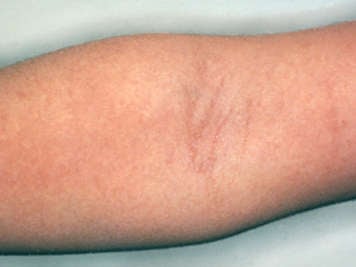
What is scarlet fever?
Scarlet fever is an infection caused by a strain of the bacteria called group A beta-haemolytic Streptococcus (GAS) or strep for short. This strain of bacteria produces a toxin (a harmful substance) that causes the scarlet rash. However, not all strains of bacteria produce this toxin.
Scarlet fever occurs most often in school-age children.
Signs and symptoms of scarlet fever

Rash
The main symptom of a scarlet fever infection is a scarlet (red-to-orange) rash that spreads along your child's skin.
- The rash often appears first on the neck and face.
- It begins by looking like a sunburn. It can feel rough, like sandpaper and may itch.
- After it appears on the neck and face, the rash spreads to the chest and back, and then the rest of the body.
- It tends to form red streaks in body creases, especially around the underarms and elbows.
- It usually fades after four to six days.
Skin peeling
The affected skin may start to peel seven to 10 days after the rash disappears and may continue to peel for up to six weeks.
Fever
Often, a fever appears one to four days before the rash.
Sore throat
If you look into your child's mouth, you may see enlarged red tonsils, sometimes covered with a white-yellow coating. The tongue may be white-red with small red dots and look like a strawberry. Not all children with scarlet fever have a sore throat or redness or swelling of the tonsils.
Other symptoms
Some children may have other symptoms like headache, nausea, vomiting, stomach-area pain and muscle pain.
Other infectious conditions (such as measles or staphylococcal skin infection) or inflammatory conditions (such as Kawasaki disease) can cause similar symptoms to scarlet fever.
How to prevent scarlet fever from spreading
The rash itself is not contagious, but the bacteria (GAS) that causes the rash is found at the back of the throat in children with scarlet fever. The bacteria can spread easily to family members and your child's classmates if your child sneezes, coughs or exhales near them. Any child or adult who lives in your home and has similar symptoms in the next five days after exposure should have a throat swab.
Your child is no longer contagious after they have been on antibiotics for 24 hours. That means your child can return to school after one day of antibiotics if they are feeling better.
Other tips to prevent spreading the infection include:
- washing hands with warm soapy water
- not sharing drinking glasses or eating utensils with friends or classmates
- washing your child's dining utensils and drinking glasses in hot soapy water or a dishwasher
- sneezing into the elbow or covering the mouth and nose when coughing
How scarlet fever is diagnosed
To find out the cause of your child's pain and rash, the doctor may take a throat swab. A throat swab is a cotton-tipped stick that the doctor wipes along the side and back of your child's throat. The swab is then tested for the GAS or strep bacteria.
How scarlet fever is treated
If the throat swab is positive for GAS, the doctor will prescribe oral antibiotics (taken by mouth) for your child.
Complications from scarlet fever
Although rare, one complication of scarlet fever is rheumatic fever, a condition that can involve the skin, joints, heart and brain. Treating the initial strep infection with antibiotics almost always prevents rheumatic fever.
Other complications can include joint inflammation (arthritis) and kidney inflammation.
Taking care of your child at home
Monitor the fever and complete the antibiotics
The fever and throat pain usually resolve within three days of your child starting antibiotics. It is important to complete the course of antibiotics, even when your child starts to feel better. Doing so prevents scarlet fever from returning or complications from developing.
You can use acetaminophen or ibuprofen to treat the fever or throat pain. You should not give ASA (acetylsalicylic acid) to children.
Ease your child's sore throat
Eating and drinking may be painful for a child with a sore throat. Here are some tips to make it easier.
- If your child is having trouble swallowing, give soft foods that are easy to swallow, such as soups, ice cream, pudding or yogurt.
- Give plenty of liquids. Sipping with a straw or sippy cup may help.
- If your child is more than one year old, try giving one to two teaspoons (5 to 10 mL) of pasteurized honey to soothe the throat and ease the cough.
- Offer older children warm salt water for gargling.
Ice cubes and lozenges may provide some relief for older children or teens, but do not give them to younger children because they are a choking hazard.
Soothing the rash
Use non-perfumed creams to soothe the skin. Pouring some oatmeal, or commercial oatmeal bathing powders, in the bath may also reduce the redness and discomfort.
When to see a doctor
Call your child's regular health-care provider if:
- the fever does not go away three days after starting antibiotics
- the rash develops blisters or open sores or if the rash becomes quite painful
- your child has difficulty drinking liquids or keeping liquids down
- your child has difficulty breathing
Your child may show physical changes when their condition is serious or when their condition gets worse. Parents and caregivers can learn how to spot these signs in order to seek help from a health-care provider.